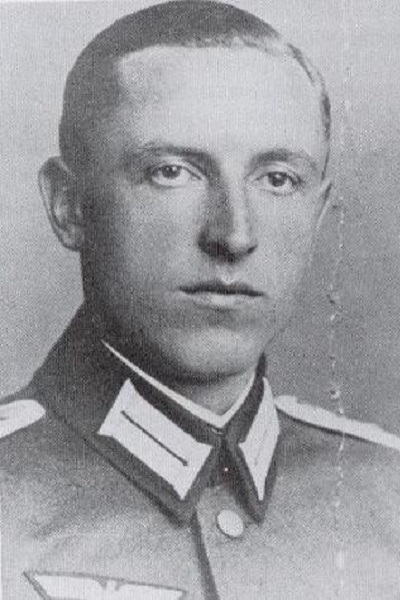Weiler, Bruno
- Date of birth:
- July 27th, 1905 (Berlin/Brandenburg, Germany)
- Date of death:
- May 8th, 1945 (Landskron/Carinthia, Germany)
- Buried on:
- German War Cemetery Cheb
- Nationality:
- German
Biography
Do you have more information about this person? Inform us!
- Period:
- Second World War (1939-1945)
- Rank:
- Oberst (Colonel)
- Unit:
- Kommandeur, Skijäger-Regiment 1, 1. Skijäger-Division, Heer
- Awarded on:
- May 9th, 1945
"On the 07.03.1945 Kampfgruppe Weiler, consisting of three Bataillone and parts of the Panzer-Jäger-Abteilung 152, was subordinated to the 371. Infanterie-Division.
At 19:00 Oberst Weiler was in Vierraben (14 km NW of Racibórz). At that time he received the order from the commander of the 371. Infanterie-Division to take the I. & III./Skijäger Regiment 1 (then based in Warmenthal) to attack and capture Gut Niederhof, and thereafter deploy in a defensive posture along the line Warmenthal—Gut Niederhof—Holderfelde.
Weiler, along with his Adjutant and Ordonnanz-Offizier, began driving at 00:00 the next day from Vierraben to Vw. Elfriedendorf via Wiesenstein. Their observation of tracer bullets and flares suggested an unclear situation at the frontline. The commander and adjutant of I./Ski-Jäger-Regiment 1 reported in at the Elfriedenhof estate. After they had marched north about 250 metres the enemy suddenly attacked from the right with several tanks and about 150 infantry, aiming towards the estate. They swiftly took up position to the east of the Elfriedenhof—Warmenthal road. After a short but violent firefight the officers of Stab Ski-Jäger-Regiment 1 (led by Oberst Weiler) defeated the initial Soviet attempts at entering the estate. However, since it was not possible for 3 officers to hold the place against the far superior enemy, Oberst Weiler decided to abandon the estate and instead establish a defensive front against the enemy who had penetrated the lines here with all the units that could be found.
Moving across friendly minefields, he went past Point 237.9 to the Reichsstraße 118, and from there took over the Kampfschule-Kompanie of the 371. Infanterie-Division as well as friendly Pak and the Panzerzerstörer-Zug of 13./Ski-Jäger-Regiment 1 (the latter two of which were in the middle of repositioning). He ordered them to move to the estate and hold it against all enemy attacks. Then Weiler went to the intersection 1 km SW of the estate and held up three Sturmgeschütze there that were withdrawing from the area, taking them under personal command. At about 02:00 the lead units of the I./Ski-Jäger-Regiment 1 reached the intersection. Oberst Weiler then made the independent decision to retake the Elfriedenhof estate with the available elements of his Bataillon and the three Sturmgeschütze, a move which went against his existing orders. Fighting at the head of his men (and despite his shot up arm and leg), the force managed to recapture the Elfriedenhof estate. They thereafter pursued the broken enemy and built a new defensive line.
Through his bold and independent decisions, Oberst Weiler prevented a dangerous enemy breakthrough, closed the gap in the frontline of the 371. Infanterie-Divison and created a new defensive position. This action was crucial for holding the main line of the 371. Infanterie-Divison and enabling it to continue the fight."
His nomination by the troop was received by the Heerespersonalamt (HPA—Army Staff Office) on 28-4-1945. It was noted in the book "Verliehene Ritterkreuze" (Awarded Knight Crosses) with an entry number Nr. 5141. Major Joachim Domaschk approved on 30-4-1945. There is no file card nor further evidence regarding its presentation can be found. According to the Association of Knight's Cross Recipients (OdR) the award was presented in accordance with the Dönitz-decree. This is illegal according to the Deutsche Dienststelle (WASt) and lacks legal justification. The presentation date was assigned by Walther-Peer Fellgiebel.
- Period:
- Second World War (1939-1945)
- Rank:
- Oberst (Colonel)
- Unit:
- Kommandeur, Skijäger-Regiment 1, 1. Skijäger-Division, Heer
- Awarded on:
- December 5th, 1944
According to other source the awarding date is 7-12-1944
- Period:
- Second World War (1939-1945)
- Awarded on:
- May 17th, 1944
- Period:
- Second World War (1939-1945)
- Awarded on:
- October 20th, 1943
- Period:
- Second World War (1939-1945)
- Rank:
- Major
- Unit:
- II. Bataillon, Infanterie-Regiment 346, 217. Infanterie-Division, Heer
- Awarded on:
- November 5th, 1942
- Period:
- Second World War (1939-1945)
- Awarded on:
- July 7th, 1942
- Period:
- Second World War (1939-1945)
- Awarded on:
- October 27th, 1941
- Period:
- Second World War (1939-1945)
- Awarded on:
- October 16th, 1941
- Period:
- Second World War (1939-1945)
- Awarded on:
- July 22nd, 1941
- Period:
- Second World War (1939-1945)
- Awarded on:
- October 3rd, 1939
Sources
- Photo 1: Igor Poul
- - FELLGIEBEL, W.P., Elite of theThird Reich, Helion & Company Limited, Solihull, 2003.
- PATZWALL, K. & SCHERZER, V., Das Deutsche Kreuz 1941-1945, Verlag Klaus D. Patzwall, Norderstedt, 2001.
- THOMAS, FRANZ & WEGMANN, GÜNTER, Die Ritterkreuzträger der Deutschen Wehrmacht 1939-1945, Biblio-Verlag, 1993.
- Scheibert, Horst. Die Träger der Ehrenblattspange des Heeres und der Waffen-SS/ Die Träger der Ehrentaffelspange der Kriegsmarine/ Die Inhaber des Ehrenpokals für Besondere Leistung im Lukftkrieg. Friedberg, Ger.: Podzun-Pallas Verlag, 1986, ISBN 3-7909-0283-7
- Axis History Forum via Awardholders / unit
- BArch RH 7/420.












